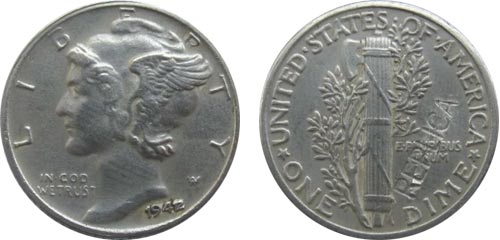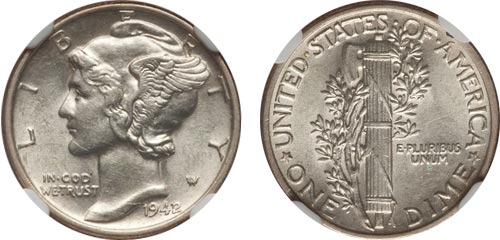Counterfeit Detection: 1942/1 Mercury Dime
Posted on 8/24/2010
Readers of this column are aware that numismatics is currently suffering from a new blight of counterfeit coins. This scourge began a bit more than five years ago, and over time the counterfeiters have become progressively more deceptive in their methods and with their capabilities. Today’s collectors are educating themselves about fakes and are certainly "on guard" when making purchases. That fact serves as one of the primary motivations of this monthly column.
Most collectors seek to avoid copies all together. This week, we’re going to recommend that you purposely look at replica coins. By looking at known fakes, you can see how they differ from real coins. It’s easy to find known fakes, too. In the United States, the Hobby Protection Act of 1990 requires that all reproductions of coins be marked "COPY" in text that is at least one-sixth of the diameter of the coin and not smaller than 6 mm x 2 mm. Thousands of replica coins labeled this way are offered for sale on eBay. They can be found by searching in the Replicas & Reproductions section of the Coins & Paper Money category.
One major caveat before we proceed: Many of these sellers who offer correctly marked fakes also produce spurious or unmarked fakes designed to deceive. We do not recommend or endorse these sellers. In fact, we strongly encourage you to ONLY look at their images.
This month, we took a look at the 1942/1 Mercury Dime, one of the best and most dramatic overdates in 20th century coinage, and one that has been widely counterfeited. By doing a quick search on eBay, we were able to find hundreds of copies. Let’s take a look at them more closely to see what we can learn.
The Wrong Mintmark Fake

This coin should be dismissed in a second. Although the date shows a clear 2 over 1, its reverse shows an S mintmark. Overdates were struck in Philadelphia and Denver, with the P-Mint version being the dramatic one we’re after today. This coin is either a fantasy or a forger’s blunder, but if you see a 1942/1-S that’s not marked "COPY," it’s not real.
Ill-Defined Letters Fake

This coin is definitely better than the last. We also see that the word replica is applied by a post-striking punch, so there’s a chance that examples of this coin exist without the marking "REPLICA." Here take note of the words IN GOD WE TRUST and E PLURIBUS UNUM. This coin falls apart quickly where the letters are small. They are misshapen, notably the U in TRUST, or faint and distinct as on the UM in UNUM. Also the reverse rims are thin or absent, unlike the genuine coin that has broad rims. If you encounter a high-grade 1942/1 dime with misshapen legends or thin reverse rims, you’ve found a fake.
The Bad Date Fake

This coin has corrected for the weak legends and rim issue that jumped out on the last coin, but presents another obvious problem for the authenticator. The date is oddly angled and too compact. It is very different from the shape and position of the date shown on genuine examples. Readers of this column will remember a previous column entitled Pass the Test that encouraged study of date logotypes. That knowledge will save you here.
The Real McCoy

Here’s a genuine example for comparison that has been certified by NGC and grades choice about uncirculated. Note the broad rims, the angle of the date and the crisp details throughout.
Stay Informed
Want news like this delivered to your inbox once a month? Subscribe to the free NGC eNewsletter today!
